
Khaled Ammar
Some people like to be small fish in a big pond. Others like to be big fish in a small pond. Khaled Ammar is a big fish in a 10,000-year-old pond, the city of Jericho.
The owner of a Jericho radio station as well as a picnic facility, Khaled is a journalist, former football player, FIFA-recognized referee since 2003, and author of four books, including one on the history of Jericho. He has been a producer with American celebrity media figures such as Ted Koppel; he has worked with Eyal Sival on his important documentary about Aqbat Jaber and has been an exclusive photographer whose works appear in the autobiography of former President Jimmy Carter. His touristic map of Jericho has been reprinted in ten languages. Any politician, sportsperson, or celebrity who has ever visited Jericho has most likely been interviewed and photographed by Khaled Ammar. He has produced 13 posters and held 32 photo exhibits that focus on Palestinian life. He has participated in seven international films and attended the signing of the Oslo Accords in Washington, DC, during which he was allowed “backstage” at the White House. He has always been the key reporter for the widest-circulating Palestinian daily in Jericho as well as a freelancer with many media outlets. If you have been to Jericho but didn’t get interviewed or photographed by this big fish, Khaled Ammar, then you are not in the record books as having visited the oldest continuously inhabited (pond) city in the world that is located at the lowest point on Earth.

Zayd Sawafta
Born in Bardala in 1977, Zayd has worked as a shepherd, a farmer, and, ultimately, an activist. He currently serves on the Local Council of Bardala, often having to battle with the Israeli army for water, access to roads and markets, and the ability to live a decent life. Zayd sits politely through endless questions about the impact of annexation, intimately documenting his decades-long struggle to sustain his farming community. He has the most minute details – places, names, and numbers – committed to memory, and he uses them to make his points about the difficulty of life as a farmer in Palestine.
Zayd explains that he has been in a game of cat and mouse with the army over the flying of the Palestinian flag. At the beginning of April, the army removed the red sign at the entrance to Bardala that indicates that the town is off-limits to Israeli citizens – the one we all have taken a picture of at some point – as a first sign that annexation will soon be under way. In response, Zayd flew the Palestinian flag to signify the town’s Palestinian identity. When ordered by the army a few days later to remove the Palestinian flag, Zayd obliged, as he did not want to see the flag defaced. That night, he had a massive flag hung over the houses of Bardala.
When asked what he thinks of annexation, Zayd responded without skipping a beat, “Don’t worry. We are here to stay. They are the ones who will leave.”
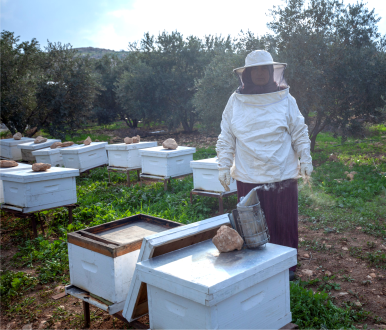
Maleka’s Bees
In her apiary in the village of Kardala in the northern Jordan Valley, Maleka moved lightly and energetically among the beehives, wearing a full beekeeping suit. Even though a strong wind was blowing, she managed to complete the process of increasing the beehive frames, hoping to increase the honey production next May. “I got stung by bees three times today,” she said, “but I got the job done.”
A mother of eight, Maleka used to work in the private apiary of the local women’s association. But then it was destroyed by bulldozers of the occupation forces. When Business Women Forum provided her with a project grant, she was able to buy 20 beehives and open her own small apiary. Extensive training helped Maleka gain the skills needed to run her own beekeeping business. She even went to Italy to visit an apiary and learn more about the production of organic honey in rural areas. “I thought I had all the skills needed for beekeeping,” Maleka said. “But during my study tour, I discovered that there is always more to learn – from the proper methods of beekeeping and breeding bees to harvesting hive products and using them to make creams, sweets, and fruit jams,” she explained.
Maleka has created a visual identity and business brand for her project to better market the quality honey and gain her customers’ trust. She has named it “The Valley Seasons” because she hopes that it will produce the finest honey in the entire northern Jordan Valley.3
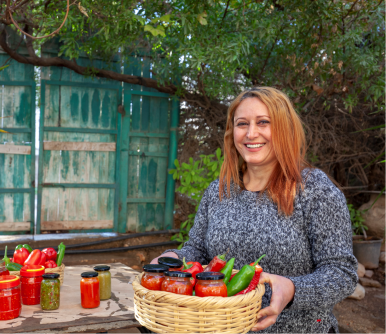
Red Pepper and Chili
In a small and stylized kitchen, Sahab Nayef, 45, stirs a mixture while talking about gardening her new pepper seedlings and the process of chili making. After 20 years of experience in traditional farming and a workshop titled Tubas Rural Business Opportunities and Social Innovation, offered by Business Women Forum, Sahab has allocated one dunum for pepper farming and learned how to implement a production plan and apply the most effective modern production techniques. Sahab now makes various types of chili that she has test-run on her brother and that first had to gain the approval of the members of her family.
Not only has her pepper production increased in quantity and improved in quality, but she has also improved her marketing skills and created a brand identity for her project with a suitable logo and project design.
Sahab offers a great product that has no competitors in the market. She looks forward to the forum’s annual exhibition as an opportunity to reach out to new customers outside the Jordan Valley.
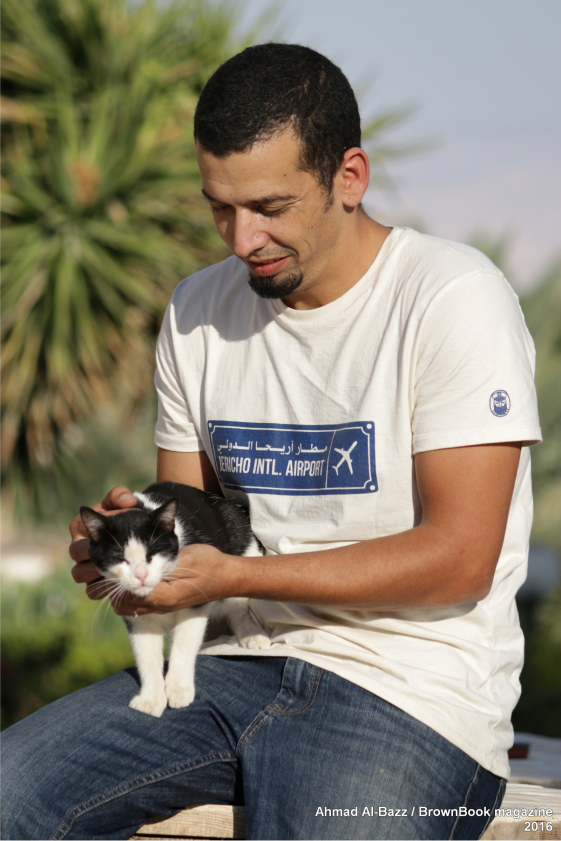
Ashraf Bakri
Ashraf Bakri launched Hantourism as an experiment to link innovative tourism projects with an increasing number of independent travelers who look for experiences beyond any prejudice in order to build a real image of Palestine through its nature, people, and stories.
Hantourism is derived from hantour, a donkey-driven carriage used to move things and people around. The ending -ism, per definition, denotes a distinctive practice, system, or philosophy. The platform offers numerous independent tourism initiatives and the opportunity to share knowledge, experiences, and values.
What began in Jericho as a grassroots effort to support independent community-based tourism service providers in Palestine has developed into an online marketing platform and booking engine that facilitates wide access to new customers for the involved network of partners that include providers of lodgings and homestays, tour guides, drivers, and other service providers. Hantourism connects these partners with travelers and consolidates their individual efforts through one unified local tourism portal. Following a sustainable, fair, and collaborative business model across the value chain, the platform connects travelers with more than 40 tourism service providers that offer an unparalleled variety of customized, off-the-beaten-track, and innovative tourism experiences in Palestine that leave long-lasting impressions and happy tourists. From getting lost in the aromas and tastes of spices in Hebron’s old souq to strolls in the footsteps of the patriarchs and matriarchs whose deeds and words shaped the stories of this land, tour guides and their connected service providers extend real value to their guest travelers as well as to their respective communities. Art, language, nature, faith, culture, food, and adventure are only some of the recurring themes across the platform’s collection of experiences.
For Ashraf, this project is an opportunity to combine his passions for community-based tourism, technology, sustainability, and social entrepreneurship. Most importantly, it allows him to share with his partners his dedication and passion to show the best of Palestine.
Haya Mohammed Kaabneh
“I express myself through art because many subjects are too sensitive for me to talk about. Art is where I value myself the most.”
Born in Jordan in 1991, Haya moved to Jericho, Palestine, and studied for a BA in fine arts at Al-Quds University. She uses watercolors or acrylic in a repertoire that includes abstracts, still life, and portraits.
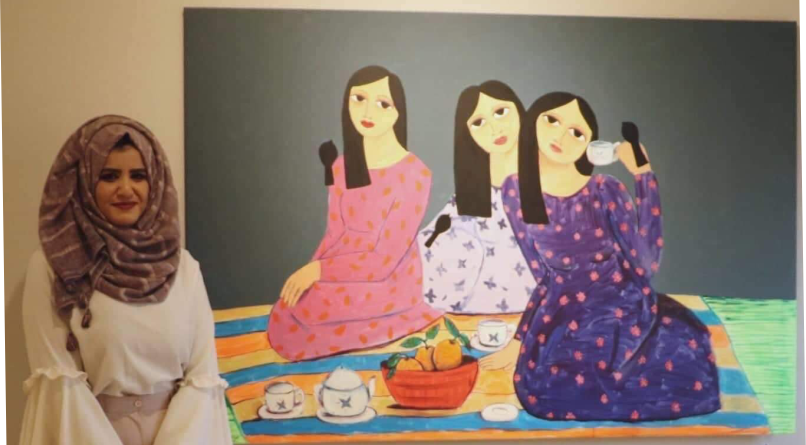
Haya’s portraits of Palestinian women are distinctive, characterizing the close family bonds and female companionship prevalent in Middle Eastern society. She consciously chooses to diverge from the stock image of the traditional Palestinian woman picking olives and dressed in an embroidered robe in order to show modern women at home in a comfortable urban setting. There is a sense of warmth and female solidarity, yet the eyes and faces of these women imply deep emotions that run below the surface. Inspired by true tales of women’s lives described by friends or family, Haya imagines the details of these stories and attempts to depict the women involved and their feelings. Each woman in Haya’s pictures has her own story that we can only guess at. For Haya, art is both a form of self-expression and an emotional release.
The dark shadows of birds in Haya’s pictures are a symbol of the search for freedom and the dreams of change aspired to by Palestinian women in the face of both a dominant patriarchal society and the Israeli occupation. Haya laments the fact that the issue of women’s rights is constantly being relegated to an inferior position on the list of priorities, pending resolution of the Palestinian cause and liberation from occupation. A powerful series of small illustrations of women blocked in front of a large STOP sign sums up the frustrations.
Haya is currently working on a new series of abstract artwork about the food cooked by Palestinian prisoners. She depicts the traditional dishes that prisoners cook to remind themselves of home, but the act of preparing these dishes allows the prisoners to feel autonomous and free, even though their freedom is curtailed.
Haya’s work has appeared in several exhibitions in various locations, including the A. M. Qattan Foundation, Ramallah, the Walled Off Hotel, Bethlehem, and the Museum of the Palestinian People in the United States.
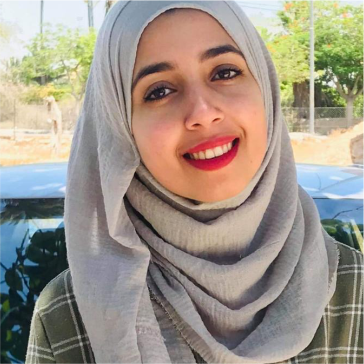
Yaqeen Yamani
Yaqeen Yamani holds a degree in media studies from Al-Quds Bard College. Living in Jericho, she has been practicing photography for seven years, and exposure to various mediums has encouraged her to explore different styles. Currently, her main interest is in image culture, particularly photography and video as an art form.
As a fresh graduate who looks forward to attending various events to learn more and be involved in the cultural scene, she has faced many difficulties as a result of living in Jericho. “Most events take place in Ramallah, which is frustrating!” she explains. “First, because it is expensive. Second, because most events happen in the evening, and it is difficult to find transportation.”
Yaqeen created Jericho Cinema Club. Her motivation was the realization that people tend to think of Jericho as a tourism center, not a cultural city. Her project aims not only to make a change by raising awareness and deepening the understanding of images as an expression of culture but also to inspire people to discuss ideas. “Not to find an answer but to create a better question,” she says. “I envision this project as a cultural center in Jericho, a place where we as youth can decide to create and bring about what we are missing. I want us to experience and fulfill our potential to the maximum.”
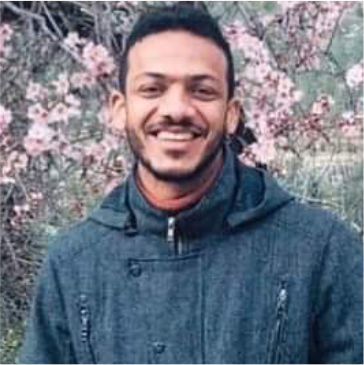
Mohammed Ghrouf
Born in Jericho – the oldest and lowest city in the world – and still living there, Mohammed Ghrouf realized early on that many typical scenes of daily life in the city had never been shown or documented. So he started to take photos of these scenes and post them online. “I love my country more than anything else,” he explains. Mohammed not only documents his city’s daily life, he has taken his hobby to the next level by going to the ancient areas of Jericho and organizing visits for groups of his friends as well.
In 2020, as we started quarantining at home, Mohammed’s passion led him even further as he created an Instagram account named #VisitJericho. “I want to encourage people to start domestic tourism and discover the beauty of our homeland,” he said.
When people welcomed his idea and began to interact with his account by sending him photos of Jericho or tagging him in their posts, Mohammed was surprised to see all this beauty through the eyes of his followers. It means a lot to him. Some photos are so beautiful that you would never believe that they were taken in the northern Jordan Valley.
His project also supports the local photographers, as he mentions their names with each photo. He invites people to ask about the locations depicted in these photos and responds to them, providing directions to the sights. Sometimes he takes groups on hiking tours to such places as the Mount of Temptation. Mohammed hopes that in the near future he will be able to promote his project and make his work more official.
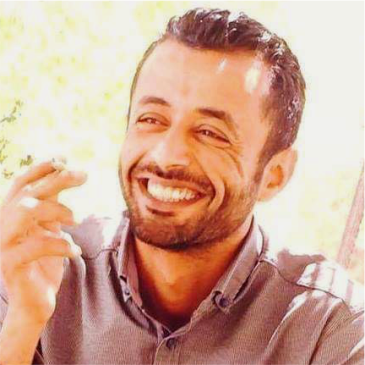
Mohanad Saaideh
Working from Auja Village in the Jordan Valley, Mohanad Saaideh engages to preserve the Palestinian heritage of the Jordan Valley. He communicates with all forms of media and international and local human rights institutions, reaching out to everyone who strives to preserve the Palestinian heritage of the Jordan Valley, with a particular focus on the Bedouin communities located in the Jordan Valley, the badia. As a photographer, Mohanad furthermore documents not only the local wildlife but also the conditions of Palestinians in the Jordan Valley, highlighting the injustices from which they suffer, such as water shortage and restrictions at many levels imposed by Israel. Finally, Mohanad works as a tourist guide in the Jordan Valley, competing with Israeli guides in the region.
“I know the special features of each one of these mountains even though they all seem to look alike,” he says with pride. “Carrying my camera, I move in the desert either by foot or on my motorbike and use Facebook to promote this area among tourists and document any sort of violations or destruction of wildlife.”
Mohanad loves the desert, where he finds freedom. Taking pictures, he finds beauty that no one else can see. He makes friends with animals, such as the little crow he found and raised when it had lost its mother. When the time was right, he released it back into the wild.
Mohanad has documented the water diversion to settlements that has caused Al-Auja Spring, one of the largest in Palestine, to dry up. He laments that the area that once was a favorite destination for Palestinian tourists has become barren and deserted, whereas green settlements have sprung up in the desert, protected by soldiers. He explains: “They steal intelligently. Water pumps are installed underground. Above, we are forbidden to approach our lands near the settlements. This has caused economic devastation among the Bedouins who were forced to leave the area because pastures adjacent to Al-Auja had dried up. Other residents have lost their work in agriculture, which has forced them to become wage workers after they had been agricultural investors.”
Mohanad documents on a daily basis through Al-Auja Environmental Center. He uses his cell phone as he travels by foot or motorbike, at times using direct broadcast technology and sometimes taking photos. He has recently started to create commercial projects that provide economic benefit to the population. He established an aquarium to breed fish and has invested in agriculture that utilizes new technologies. He asserts, “We will continue to find ideas that bring life to this region whose natural and economic value is known only to a few. We will learn a lot from our enemy and will work to restore human life here through commercial projects. And we will revive the wildlife around us. It is ours, and we have the right to enjoy its beauty!”

